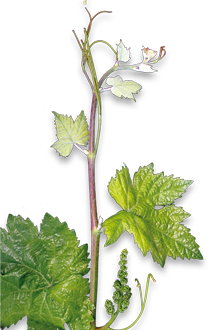Xarello (ES)
Variety: white | Category III | Spain


General Information
Xarello


Origin: This variety comes from Catalonia, with widespread distribution in the North-East. It is one of the three Cava sparkling wine varieties.
Chief areas of distribution: Mainly concentrated in the D.O. Penedès, and as the Panse Blanca in the D.O. Alella
Official synonym(s) (national and OIV): Cartoixa, Pansa Blanca, Pansal.
Historic and regional synonyms: Cartoixa, Cartuja, Cartuxa, Moll, Pansa, Pansa Blanca, Pansal, Pansalat, Pansalet, Pansar, Pensal, Prensa Branco, Vinate, Vinyater, Xarell-Lo, Xarel.lo , Xarelo Blanco.
Homonym(s): Not yet determined.
Area under cultivation: 8,000 ha (Ministry of Agriculture, 2007).
Trend: Regional, slightly downward, although stabilising.
Varietal variability: Low.
Availability of propagating material: Catalonia has the following clone material available: I-20, I-23, I-57, I-69.
Molecular Profile (OIV)
Regional Classification
Morphology
Phenology
Vegetative Potential
Viticultural Parameters
Oenology
Variety Characteristics
| VVMD5 | VVMD7 | VVMD27 | VrZag62 | VrZag79 | VVS2 | ||||||
| Allele1 | Allele2 | Allele1 | Allele2 | Allele1 | Allele2 | Allele1 | Allele2 | Allele1 | Allele2 | Allele1 | Allele2 |
| 232 | 236 | 237 | 241 | 177 | 185 | 185 | 187 | 241 | 245 | 130 | 140 |
Recommended in Portugal: Catalonia.
Authorized: Aragon, Estremadura, Navarre, the Basque Country.
DOC quality wine: DO Alella, Cataluña, Cava, Costers del Segre, Empordá, Montsant, Penedès and Tarragona. DOCa Priorato.
Young shoot (form of tip): High density erect hairs with medium to strong anthocyanin colouration.
Young leaf: None, or very low anthocyanin colouration of the first six leaves, dense prostrate hairs between veins, hairs on medium density on the veins.
Young shoot: Green with red stripes on the dorsal side. Glabrous at nodes and internodes.
Inflorescence (sex of flower): Hermaphrodite.
Mature leaf: Circular to pentagonal, almost closed slightly overlapping petiolar sinus, medium expression in main veins, free, sparsely notched upper lateral sinuses, absence or very low anthocyanin colouration, sparse prostrate hairs and erect hairs on main veins, reddish petiole with extremely sparse hairs, petiole somewhat longer than the main vein. Right-angled convex teeth of medium size and medium length-width ratio.
Bunch: Medium in size, dense, short peduncle.
Berry: Medium to large, uniform, round, difficult to detach, thick berry skin. Flesh mostly colourless, slightly juicy.
Woody shoot: Dark brown, striped.
Time of bud burst: Medium.
Flowering: Normal.
Berry (colour change): Normal to late.
Berry (harvest ripe): Medium.
Vigour of shoot growth: Medium to high.
Pruning weight:: High.
Shoot attitude (habit): Heliotropic, with a tendncy to grow very high, then fall down.
Length of internodes: Long.
Shoot length: Very long.
Tendency to form lateral shoots: Very high.
Rate of multiple bud bursts: Low, or none.
Bud fertility index: Low.
Yield consistency: Quite consistent.
Crop uniformity: Variable.
Winkler Index: 4, on a scale of 1 to 5.
Sensitivity to abiotic factors: Sensistive to rainfall at flowering.
Susceptibility to fungal diseases: Medium.
Susceptibility to Pests: Sour worm and red spider mite.
Bunch weight: Heavy.
Seeds per berry: 3-4.
Vineyard conduction system: Vase, cordon, Guyot.
Pruning: Low fertility of the basal bud requires long or mixed pruning.
Green pruning: Complete before flowering.
Soil requirement: Suitable for all soils.
Climatic requirements: Moderately warm.
Vine density: 2.500 vines/ha.
Rootstock: No known incompatibility; particularly compatible with 41B.
Incidence of coulure/millerandage: Very high.
Spoilage of mature berries: Very minimal.
Risk of bird damage: Low.
Machine harvest suitability: Well suited.
Hand harvest suitability: Suitable.
Wine type: Wines from Xarello are well suited to barrel ageing, are an important ingredient in Cava sparkling wines, and suitable as young table wines.
Potential alcohol content: 11% – 14% vol.
Natural acidity of must: High.
Total anthocyanins: None or very low
Risk of oxidation of must: Very high.
Tendency towards acidity loss in fermentation: Very high.
Colour intensity of wine: Yellow-gold.
Wine colour tonality: Yellow-gold.
Tannins: None or very low.
Total polyphenol index (at 280 nm): 7.
Risk of oxidation of wine: Low.
Aromatic profile: Terpene, strong stone fruit aroma.
Ageing Potential: Good.
Blending recommendation: As a table wine, with Macabeo; as a cava wine with Parellada and Macabeo.
Wine Descriptors: The wine is yellow gold in appearance, with an initial rustic aroma. It is full-bodied with stone fruit notes and vegetal echoes of fresh white cabbage. Good acid structure.
Wine quality: Excellent Cava–base wine. Somewhat suitable as a barrel aged varietal.

